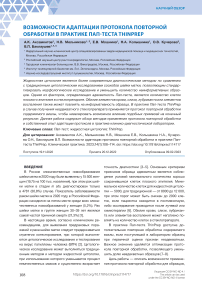Возможности адаптации протокола повторной обработки в практике Пап-теста ThinPrep
Автор: Аксаментов Артем Константинович, Мельникова Надежда Васильевна, Мошнина Евгения Викторовна, Колышкина Надежда Александровна, Кучерова Ольга Николаевна, Баклаушев Владимир Павлович
Журнал: Клиническая практика @clinpractice
Рубрика: Научные обзоры
Статья в выпуске: 1 т.14, 2023 года.
Бесплатный доступ
Жидкостная цитология является более современным диагностическим методом по сравнению с традиционным цитологическим исследованием соскобов шейки матки, позволяющим стандартизировать морфологическое исследование и уменьшить количество неинформативных образцов. Одним из факторов, определяющих адекватность Пап-теста, является количество клеток плоского эпителия в стеклопрепарате. Обилие элементов крови, слизи, лубриканта или элементов воспаления также может повлиять на информативность образца. В практике Пап-теста ThinPrep в случае получения неадекватного стеклопрепарата применяется протокол повторной обработки содержимого виалы, чтобы нивелировать возможное влияние подобных примесей на конечный результат. Данная работа содержит обзор методов применения протокола повторной обработки и собственный опыт адаптации протокола в практике клинико-диагностической лаборатории.
Пап-тест, жидкостная цитология, thinprep
Короткий адрес: https://sciup.org/143179879
IDR: 143179879 | DOI: 10.17816/clinpract114717
Список литературы Возможности адаптации протокола повторной обработки в практике Пап-теста ThinPrep
- Злокачественные новообразования в России в 2020 году (заболеваемость и смертность) / под ред. А.Д. Каприна, В.В. Старинского, А.О. Шахзадовой. Москва: МНИОИ им. П.А. Герцена, 2021. 252 р. [Malignant neoplasms in Russia in 2020 (morbidity and mortality). Ed. by A.D. Kaprin, V.V. Starinsky, A.O. Shakhzadova. Moscow: P.A. Herzen Moscow State Research Institute; 2021. 252 p. (In Russ).]
- Клинические рекомендации. Цервикальная интраэпителиальная неоплазия, эрозия и эктропион шейки матки. 2020. [Clinical recommendations. Cervical intraepithelial neoplasia, erosion and ectropion of the cervix. 2020. (In Russ).]
- Rozemeijer K, Penning C, Siebers AG, et al. Comparing SurePath, ThinPrep, and conventional cytology as primary test method: SurePath is associated with increased CIN II+ detection rates. Cancer Causes Control. 2016;27(1):15–25. doi: 10.1007/s10552-015-0678-1
- De Oliveira AC, Domingues MF, Neufeld PM, et al. Comparison between conventional cytology and liquid-based cytology in the Tertiary Brazilian Navy Hospital in Rio de Janeiro. Acta Cytol. 2020;64(6):539–546. doi: 10.1159/000508018
- Taylor S, Kuhn L, Dupree W, et al. Direct comparison of liquidbased and conventional cytology in a South African screening trial. Int J Cancer. 2006;118(4):957–962. doi: 10.1002/ijc.21434
- Цервикальная цитология по системе Бетесда: терминология, критерии и пояснения / под ред. Р. Найяр, Д. Уилбура; пер. с англ. под ред. Н.Ю. Полонской. Москва: Практическая медицина, 2017. 304 с. [Cervical cytology according to the Bethesda system: Terminology, criteria and explanations. Ed. by R. Nayyar, D. Wilbur; translated from English ed. By N.Y. Polonskaya. Moscow: Prakticheskaya meditsina; 2017. 304 p. (In Russ).]
- Risley C, Geisinger KR, Robinson JC, et al. Precancerous cervical lesions and HPV genotypes identified in previously unsatisfactory cervical smear tests after inexpensive glacial acetic acid processing. Int J Gynaecol Obstet. 2019;144(1): 85–89. doi: 10.1002/ijgo.12699
- Kalinicheva T, Frisch N, Giorgadze T, et al. Etiologic factors related to unsatisfactory ThinPrep cervical cytology: Evaluation and potential solutions to improve. Cytojournal. 2015;12:21. doi: 10.4103/1742-6413.165955
- Rosa M, Pragasam P, Saremian J, et al. The unsatisfactory ThinPrep Pap Test: Analysis of technical aspects, most common causes, and recommendations for improvement. Diagn Cytopathol. 2013;41(7):588–594. doi: 10.1002/dc.22904
- Jeong H, Hong SR, Chae SW, et al. Comparison of unsatisfactory samples from conventional smear versus liquid-based cytology in uterine cervical cancer screening test. J Pathol Transl Med. 2017;51(3):314–319. doi: 10.4132/jptm.2017.03.17
- Cohen D, Shorie J, Biscotti C. Glacial acetic acid treatment and atypical endocervical glandular cells: An analysis of 92 cases. Am J Clin Pathol. 2010;133(5):799–801. doi: 10.1309/AJCP8N9ZJQDHFYTC
- Dalton P, MacDonald S, Boerner S. Acetic acid recovery of gynecologic liquid-based samples of apparent low squamous cellularity. Acta Cytol. 2006;50(2):136–140. doi: 10.1159/000325921
- Kitchener HC, Gittins M, Desai M, et al. A study of cellular counting to determine minimum thresholds for adequacy for liquid-based cervical cytology using a survey and counting protocol. Health Technol Assess. 2015;19(22):1–64. doi: 10.3310/hta19220
- Gupta N, John D, Dudding N, et al. Factors contributing to false-negative and potential false-negative cytology reports in SurePath liquid-based cervical cytology. Cytopathology. 2013; 24(1):39–43. doi: 10.1111/j.1365-2303.2012.00992.x
- Munson E, Chateau KD, Nelson BE, et al. Effect of glacial acetic acid treatment of liquid-based cytology collections on performance of Cervista HPV HR for detection of high-risk human papillomavirus. J Clin Microbiol. 2012;50(6):2129–2131. doi: 10.1128/JCM.06719-11
- Munson E, Schroeder ER, Ross KC, et al. Effect of preanalytical processing of ThinPrep specimens on detection of high-risk human papillomavirus by the Aptima HPV assay. J Clin Microbiol. 2014;52(5):1448–1452. doi: 10.1128/JCM.03624-13
- McMenamin M, McKenna M. Effect of glacial acetic acid treatment of cervical ThinPrep specimens on HPV DNA detection with the cobas 4800 HPV test. Cytopathology. 2013; 4(5):321–326. doi: 10.1111/cyt.12052


